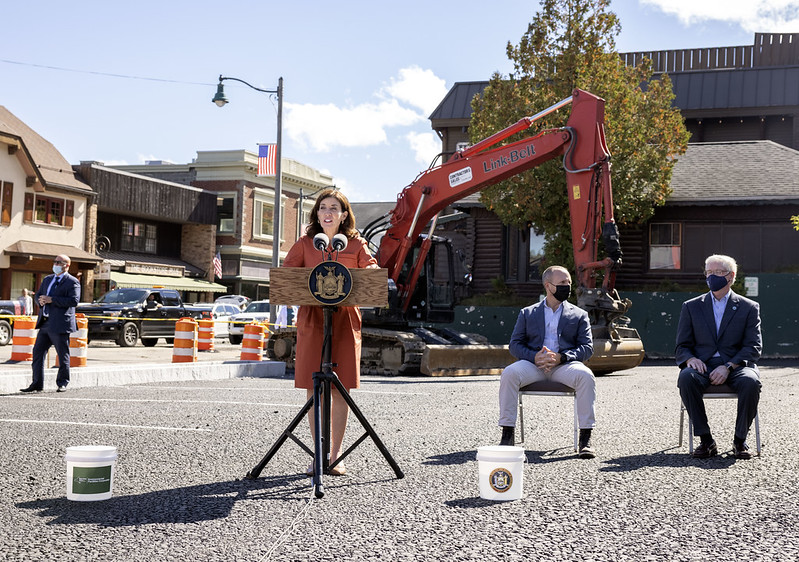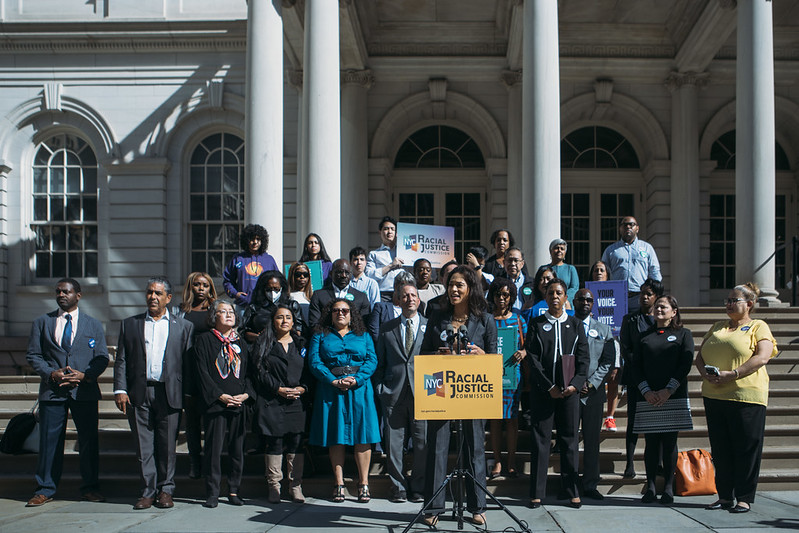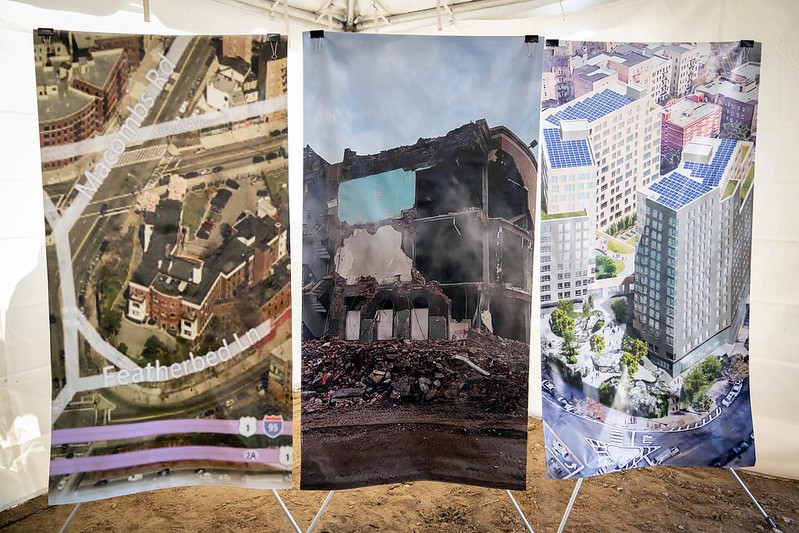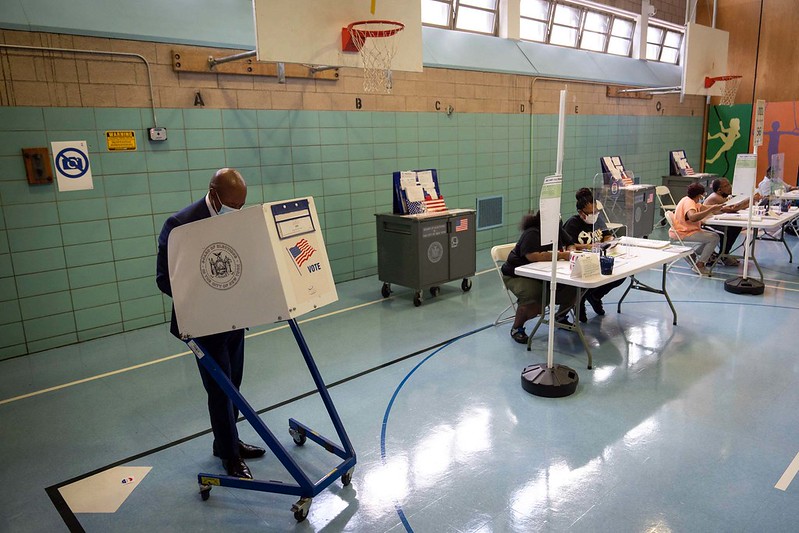To Honor Essential Workers, Congress Must Save Public Transit
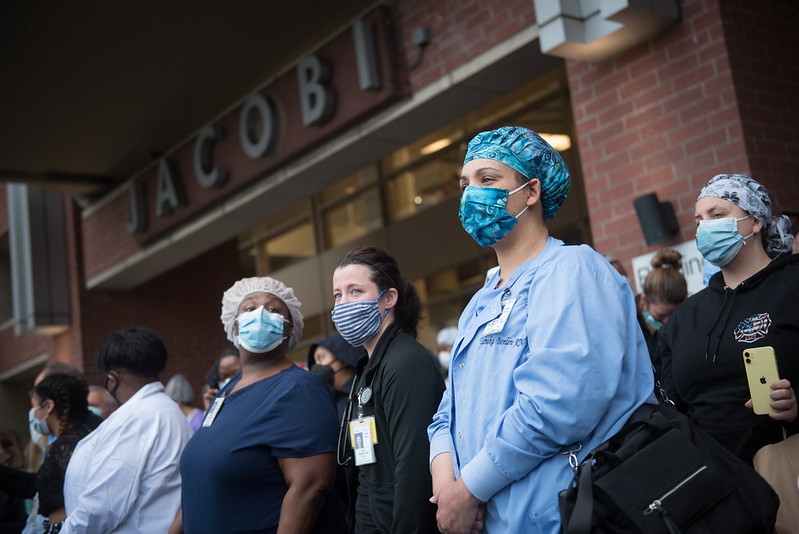
Nurses and other essential workers need public transit (photo: Michael Appleton/Mayor's Office)
I am a lifelong New Yorker and public transit rider. In March, when so many of my friends, family, and neighbors stopped commuting, I kept traveling to work. I depend on a bus and two subways to get from my Queens home to the East Side of Manhattan hospital where I’m a pharmacist.
Like most people, I had never heard of “essential workers” before COVID-19. Everyone I knew got up and went to work regardless of what job they had. And thankfully, many I know are still employed, though working from home. I found out that being an essential worker, besides fighting COVID directly, meant still having to commute while others sheltered at home.
As a commuter during COVID, I have depended on transit more than ever. Without a car, the bus and subways were my lifeline. Without public transit, I could not reach nor serve my patients. More this year than ever, I need reliable service. Especially when service was reduced for months, any delay became magnified and more frustrating than before.
I am so grateful for the transit workers who showed up so that I could show up too. It has been heartrending to hear of the losses among bus drivers, train operators and conductors. I don’t always think of myself as a hero just because I work in a hospital during a pandemic. But if I am one, the people getting me there every day despite everything are certainly heroes as well.
Now, as I watch terrified while COVID cases rise around the country, I also fear for my commute here in New York. I know firsthand how many fewer people have been commuting through the pandemic. I understand how much less money the Metropolitan Transportation Authority (MTA) has from fares, and from tolls and taxes as well.
In March, New York’s Congressional leaders brought home $3.9 billion to keep trains and buses running through the worst of the pandemic in New York. But that money is nearly gone. The MTA is back to normal service and doing a lot more cleaning, still with relatively little money coming in. To avoid huge cuts next month, the agency needs another $3.9 billion.
In May, New York’s members in the House of Representatives put $3.9 billion for the MTA in the House’s $3 trillion HEROES Act. But Senate Majority Leader Mitch McConnell hasn’t taken up the bill. With COVID worsening nationwide, it now looks like another aid bill will start moving through the Senate soon. Congress must again take care of the MTA and people like me who depend on it.
Without more aid, the MTA will soon be short half the money it needs on a monthly basis. With a $17 billion annual budget, it could soon face a gap of $650 million each month. That’s a lot of trains and buses that would have to stop running.
To put it into perspective, the MTA’s last major cuts came in 2010 to save $400 million over one year. Today’s cuts could be 20 times larger than that. Last time, the MTA cut the V and W trains and cut or reduced service on 110 bus lines. In a report from 2011, they found that 15% of riders were inconvenienced by the cuts. A decade later, bus ridership had dropped 25%.
Cuts 20 times larger than those of 2010 could mean entire subway trunk lines shut down. The Riders Alliance recently produced a subway map with half the lines removed. Even if it’s not quite that bad, we could be waiting 20 to 30 minutes for trains during much of the day. Crowding would be very dangerous. Fares could rise by several dollars even as service is far worse.
Life as we know it in New York would be devastated if Congress does not rescue the MTA. We have already known so much unprecedented hardship this year. For essential workers like me, it is unimaginable what a cruel blow to the infrastructure we depend on would mean after what we’ve already experienced on the frontlines of COVID. It also makes me worry about some of our patients, who rely on public transportation to get to their medical care. The MTA cut would be another barrier for them to overcome to stay healthy.
Our influential leaders in Congress must stand up for us. We need our New York leaders in the House and the Senate to speak up now more than ever. They must tell their colleagues how letting New York’s transit system collapse would destroy our recovery and bring the nation down with us. Leaders like Senator Chuck Schumer and Representative Hakeem Jeffries -- and the entire New York delegation -- must use the great power they’ve built in Washington to save the commutes of millions back home in New York City.
***
Suk-Yee Wong is a pharmacist who lives in Queens and works in Manhattan.
***
Have an op-ed idea or submission for Gotham Gazette? Email This email address is being protected from spambots. You need JavaScript enabled to view it.
Congress Returns; New York’s Future Hangs in the Balance
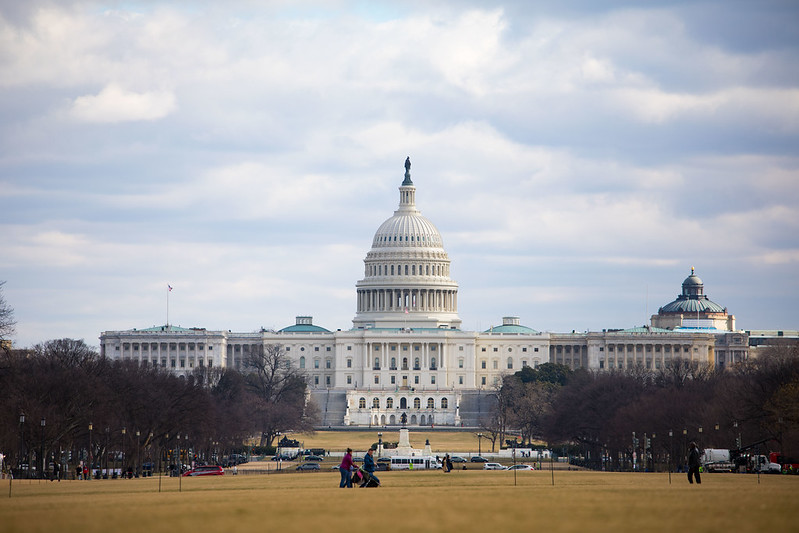
The U.S. Capitol (photo: Benjamin Kanter/Mayoral Photo Office)
With Congress back in Washington, D.C., New Yorkers have a big stake in the outcome of the next federal economic stimulus package.
No Clear Signals on New Aid to State and Local Government
Serious negotiations are finally starting on an aid program to help an American economy devastated by the coronavirus recession. Two months have elapsed since the Democrats in the House of Representatives passed a $3 trillion aid package that included $1 trillion in support for state and local government, territories, and tribal nations across the country. The Republicans in the Senate are finally responding and are anticipated to introduce a bill soon.
The unique $600 a week supplement to regular unemployment insurance benefits that has aided tens of millions of Americans and shored up consumer spending expires on July 31, and in some states like New York, on July 26. While discussions are underway about an extension of some kind, there is considerable conservative opposition to continuing that generous benefit level.
With the election just a few months away, I cannot imagine there will be another stimulus package beyond the next one that is enacted before the November election (barring a national economic collapse), so whatever gets passed now will have to last many months.
New York State and City Have Enormous Budget Deficits
New York State, New York City, and the MTA all have immense budget deficits and need major help. The New York State government, responding to the plunging economy, adopted a budget in April with $10 billion in spending cutbacks, but has yet to implement most of that plan. The State Division of the Budget’s July 8 update says final details on cutbacks will be developed and notice given to service providers once the federal package is known.
The MTA is on the Brink of a “Four Alarm Fire” Crisis
The MTA is the most desperate of these three huge New York governmental sectors. In April subway ridership was down 95% as the lockdown began, and even last week was down 80% from normal, according to a July newsletter from New York City Comptroller Scott Stringer.
The MTA has described its problems as a “four-alarm fire.” Despite receiving $3.8 billion in the first round of Congressional support, it says it needs another $3.9 billion for the remainder of 2020, and shortfalls of $4.5-$8.7 billion remain through the end of 2021. The MTA will have little choice but to scale back some of its ambitious capital expansion plans, and may have to divert new tax revenue in a “lockbox” to help pay for those projects instead toward rescuing the operating system. If the MTA cannot get major new support from Congress, the state and the city will have to step up to help the agency as a last resort. The state authorized the MTA to borrow money to prop up its budget, but the agency is in such bad shape it may not be able to borrow the billions it needs and the state may have to borrow money on its behalf.
New York’s Lockdown Losses Are Staggering
The lockdown of the economy in New York State brought a staggering loss of 1.8 million jobs, including 900,000 in New York City, between February and April. Recovery has been slow and painful. The most recent Bureau of Labor Statistics update for New York, released July 17, showed the state regained about 300,000 jobs in June, after gaining about 100,000 jobs in May. Although the economy was regaining jobs, unemployment rates in New York rose in June because more New Yorkers re-entered the labor force than found work. The unemployment rate in the state rose from 14.7% in May to 15.4% in June, and the unemployment rate in the City rose from 18.3% in May to 20.4% in June.
2.6 million New Yorkers were on unemployment benefits at the end of June. Governor Cuomo remains cautious in allowing New York City to reopen, but New York’s slow reopening may end up with the state in a better position than other parts of the country where the coronavirus is exploding and parts of the economy are reclosing.
New York Has Taken Some Intermediate Actions to Address the Deficit
New York took limited action this spring to address its financial problems while waiting for help. The New York State Comptroller’s Office reported that state tax receipts were down 17% in June 2020 compared to June 2019. The State Division of the Budget, in the July 8 report cited above, said it will have withheld about $1.2 billion in local aid through early July, about half the rate necessary to achieve the full spending cuts in the adopted budget.
Governor Cuomo, during his daily briefings on the coronavirus this spring, said local aid cutbacks could reach 20% in education, 20% to hospitals, and 20% for other local government services that would imperil first responders, absent new federal support. The state budget also provided for $2 billion in state agency cutbacks.
New York’s Choices: Slash the Budget or Borrow
Whatever happens in Washington in the next several weeks, New York will face major challenges. New York doesn’t just face a $10 billion deficit this year, it faces a projected $8 billion deficit next year and continued problems thereafter.
The state government was authorized in the budget to borrow up to $11 billion this year, initially for cash flow purposes for just one year, but the law permits the state to extend that borrowing long-term. If federal aid is inadequate, New York will face the choice of slashing the budget or borrowing at least some of whatever deficit remains after federal aid has been provided to mitigate service cuts. The state may also have to bail out the MTA and consider the City of New York’s own request that it be permitted to borrow money for short-term operating expenses.
The New York City Adopted Budget’s Labor Provisions
New York City adopted its own budget in time for the July 1 start of the new fiscal year. It was filled with placeholders, the largest of which is $2 billion in new federal aid, which has not been passed and is the subject now at hand in Washington. The city budget also has a $1 billion placeholder for the de Blasio administration to negotiate savings in wages and benefits with the public employee unions. The mayor has said the city will have to lay off up to 22,000 employees beginning in October if it cannot achieve these savings.
The New York City Police Department ended up with modest cuts. Personnel moves will bring the size of the police officer force from 36,000 to 34,000, and the city has set a saving of $350 million in the police overtime budget. School security officers will be transferred from the Police Department to the Department of Education, which will reduce the police budget by $500 million, but the money will simply be spent in another agency.
The city used $4 billion in reserves to balance its budget, drawing down nearly all of its General Reserves, as well as about half the funds in a Retiree Health Benefits Trust. In the original proposed budget in April, the city projected it will have a $5 billion deficit next fiscal year, 2021-22, with little cushion left from its depleted reserves. Projected deficits for 2020-21 increased later this spring, meaning the ‘21-22 deficit could grow past $5 billion.
The adopted city budget did not anticipate any further cutbacks from the state government, despite the State’s Financial Plan with $8 billion in local aid cutbacks (which included other municipalities, not just New York City). The extent of aid in the federal package, therefore, will affect both the level of cutbacks from the state to the city, and the city’s own budget level.
The state and city both faced increased health care and emergency expenses above and beyond their normal budgets, but some federal aid from the original package is still untapped due to the failure of the Trump administration to provide guidance on how to spend the money and can be directed to provide relief.
The Answer, of course, is the Election: A New Progressive (or At Least Liberal) Government
Federal financial relief that just replaces revenue lost from economic decline can only last so long. If any relief package enacted now has a short duration, state and local government retraction is likely inevitable given how slowly the overall economy may recover from the virus. In the Great Recession, the Obama 2009 stimulus package expired in 2011 as the Republicans were coming back into power after winning back the House of Representatives in 2010. They restricted federal spending and the nation lost 500,000 jobs in state and local government over a several year period, slowing down the overall economic recovery. Let’s hope the same mistake is not made again, and that a new progressive government in the United States arrives to the rescue soon.
***
Jim Brennan was a member of the New York State Assembly for 32 years, where he chaired four committees. On Twitter @JimBrennanNY.
***
Have an op-ed idea or submission for Gotham Gazette? Email This email address is being protected from spambots. You need JavaScript enabled to view it.
A Police Reform Agenda for the Next City Council

NYPD officers on the scene (photo: Benjamin Kanter/Mayoral Photo Office)
Watching racial injustice at the forefront of our national conversation in recent weeks has inspired millions of people across the nation to leave their homes and get involved in our democracy — some for the first time ever. Together, people in New York City from Brooklyn to the Upper East Side to Jackson Heights have all said enough is enough. It is time for city leadership to stand up and respond.
I am running for the New York City Council because I know we can do better than the system we have. The Council’s recent budget vote was a superficial attempt at change that missed the mark. We need real leadership on policing issues, not performative gestures and accounting gimmicks aimed at mollifying people seeking genuine progress. My plan aims to change the relationship between communities and policing, with the goal of engendering actual public safety, not a militarized city.
First, I will create a public safety task force for my district, which includes parts of the Upper East Side, East Midtown, East Harlem and Roosevelt Island, that is made up of community leaders and experts in policing. I will meet with these resident advisors on a monthly basis to develop immediate strategies for policing in the community, and create a long-term vision of what policing should look like in the City of New York.
Additionally, I will introduce legislation to create a five-year moratorium on the hiring of any new law enforcement officers by the city — that includes the NYPD, Corrections, and any other agency that has in-house policing. We are not going to solve the problem of over-policing in our communities while still adding to the payrolls of law enforcement agencies.
To further reduce these payrolls, we can offer early retirement incentives for people who are eligible, or near eligible, to retire, also saving the city’s deficit-ridden balance sheet. We also cannot balance the NYPD’s payroll on the backs of its non-law enforcement civilian workforce, which is largely lower-income, people of color who are not sworn officers. Changing our policing will not be accomplished with accounting gimmicks that target civilian, administrative staff.
I’ll also advocate for consistent budget cuts to the NYPD and other policing entities. The New York City budget is a statement of values as much as it is a financial document. Our community needs funding for senior services, affordable and public housing, transportation upgrades and accessibility, to name just a few important examples. I will advocate for equitable budgets that prioritize social services and defund over-spending on police.
Next, I will introduce a ban on any new law enforcement equipment acquired from the U.S. Department of Defense and mandate the city’s law enforcement agencies return any non-protective equipment (allowing agencies to keep basic materials like bulletproof vests or gloves).
Ending policing in our schools will be one of the toughest mountains to climb. In the era of school shootings we tragically live in, schools may need some level of security. However, students should not be subject to policing that could negatively impact them for years to come. We need to put a stronger focus on identifying students who are at risk of a mental health crisis before it ever becomes violent. We do need to prevent strangers from coming into school buildings and to address issues where non-custodial parents may seek to remove children from schools. But we must eliminate the school safety officers as we now know them. Students in schools should be safe from threats; they are not a threat. Law enforcement in schools in its current iteration must end.
This is not the end of the conversation or the work, but just the beginning. Billions of dollars need to come out of the city’s police budget and be invested in the tools that build stronger communities: education, the social safety net, good jobs and quality, affordable housing. We cannot lose sight of the need for policing to make communities safer, not menace the people who live there. Much needs to be done to create healing in our communities for people to feel truly safe. Let’s organize together to build the future New York we want to see.
***
Rebecca Lamorte is a Democratic candidate for New York City Council in Manhattan’s 5th District. On Twitter @RebeccaLamorte.
***
Have an op-ed idea or submission for Gotham Gazette? Email This email address is being protected from spambots. You need JavaScript enabled to view it.
New York Must Address Racist State Violence from Policing to Jails and Prisons
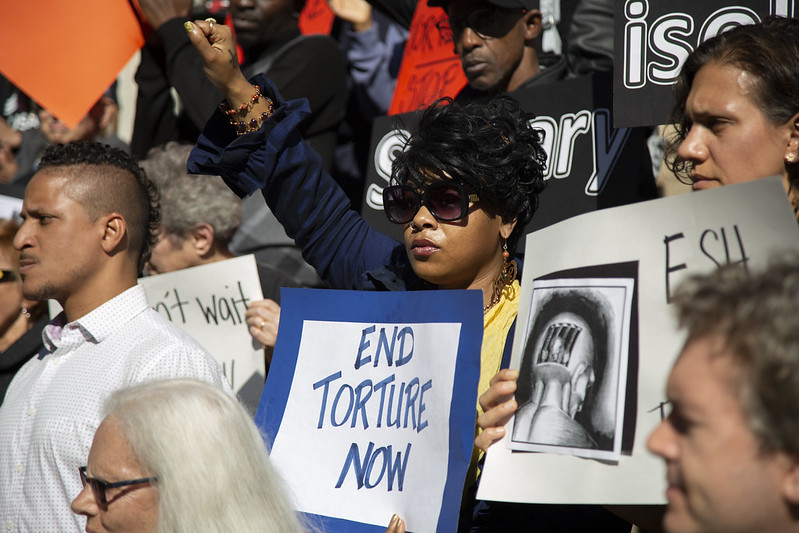
A rally to end solitary confinement (photo: John McCarten/City Council)
On April 14, 60-year-old Leonard Carter died of COVID-19 while incarcerated at Queensboro Correctional Facility. He had already been granted parole and, after a quarter century behind bars, was just weeks from his release date. He was the brother of one of us writing to demand change here today.
While public attention has focused on the brutality of police in Black communities, that is just the front end of a system designed to control, dehumanize, and brutalize Black people. Calls to defund the police and dismantle systems of white supremacy must be expanded to include the institutions whose role is to criminalize, cage, and brutalize Black bodies, from prosecutors to the Department of Corrections and Community Supervision.
As a formerly incarcerated Black activist, a Black New York State Assemblymember representing Brownsville, Brooklyn, and the sister of a Black man who died of COVID-19 behind bars, we know that racist state violence pervades not just policing, but courthouses, jails, and prisons, too.
The anti-Black violence of our criminal legal system is not located in some far away city or state. Here in New York, Black people are more likely to have money bail set and be jailed before trial. We are more likely to be coerced into plea deals that include jail time. We are more likely to be incarcerated on a technical violation of parole or probation. We are more likely to be subject to the torture of solitary confinement. While only 18% of New Yorkers are Black, we represent 48% of people in state prison and 57% of people in solitary. During the height of the COVID-19 pandemic, 80% of people who died of coronavirus behind bars were people of color.
Earlier this month, New York’s Legislature repealed 50-a, a state law that had been used to shield police misconduct records from public view. This was a culmination of a years-long campaign led by families of people killed by the NYPD and a critical step towards greater police accountability and transparency.
But it was simply a first step. To achieve justice for Black people, we must fundamentally shift resources away from policing and systems of criminalization and towards the community investments that truly keep us safe: education, affordable housing, quality health-care, youth programs. At the same time, we must center the voices of marginalized Black people: Black undocumented people, Black incarcerated people, Black trans people.
The Legislature must not lose sight of the devastation wrought on Black New Yorkers by the full system of mass criminalization and state violence. In our fight to defend Black lives, we must repeal the “walking while trans ban” to protect Black and brown trans women from harassment by the police. We must pass the Protect Our Courts Act -- passed by the Assembly on Monday and awaiting Senate action -- to codify a recent court ruling protecting Black and brown immigrants from the terror of ICE arrests in and around courthouses. We must pass the HALT Solitary Confinement Act to end this torture behind bars. And we must pass Elder Parole and Fair and Timely Parole to end death-by-incarceration of Black elders.
While we mourn with those who knew and loved George Floyd, Breonna Taylor, Tony McDade, and Ahmaud Arbery, we also mourn the death of Cynthia’s brother Leonard Carter. We mourn the deaths of Kalief Browder, Layleen Polanco, Lulu Benson-Seay, Benjamin Smalls, Dante Taylor, Valerie Gaiter, Samuel Harrell, and all those who have died at the hands of racist state violence, often behind jail or prison walls. In their names, we commit to the struggle to dismantle the carceral state and build the power of our communities. We call on the New York Legislature to do the same.
***
Assemblymember Latrice Walker represents Brooklyn’s 55th District. Marvin Mayfield is a New York State Organizer at Center for Community Alternatives. Cynthia Carter-Young is a lifelong Brooklynite and the sister of Leonard Carter.
***
Have an op-ed idea or submission for Gotham Gazette? Email This email address is being protected from spambots. You need JavaScript enabled to view it.
Returning Power to the People by Rebalancing the State Budget Process

Gov. Cuomo presents a budget plan (photo: Darren McGee/Governor's Office)
The job of state legislators is to craft laws that protect New Yorkers and advance equal opportunity and justice. A significant part of that job is shaping our state budget, which funds our schools, our health care, our transportation systems, and a long list of vital other public services. During a global pandemic, this already crucial responsibility has reached a new level of importance. But, over the years, in the strange world of Albany, the role and power of the New York Legislature during the budget process has been stripped away.
It’s time to re-balance the power between the Legislative and Executive branches of state government, and take back the people’s seat at the table, by amending the State Constitution and passing the Budget Equity Act.
Government works best when the checks and balances inherent to our democratic process remain unobstructed, we honor the bulwarks of our democracy, and empower co-equal branches of government. This is true at the federal level, and also at the state and local levels.
Our democracy was built on the idea that no person or branch of government should accrue too much power. But this democratic principle is not upheld in New York State. This is because a long line of governors have increasingly used a state constitutional provision from 1927 to minimize the role of legislators and grow their own centralized power in the budget process. In addition to seizing dominant control over how to fund or cut critical services, they have used their power to further their own policy agendas by putting consequential legislation directly into the state budget.
When the executive branch puts policy directly into the budget, the language cannot be amended by the Legislature. Unless the governor chooses to change their own budget bill, the Legislature’s only option is to go along with what the governor demands or reject the budget entirely. There is no debate, no room for change, no room for anyone else’s opinions – most importantly the public’s. And for years now, governors have been pushing the bounds of their executive power far beyond the purely budgetary matters for which it was intended.
This end-run around the legislative process has been used to create laws without allowing for the open and public process that new policies deserve. For example, just this year, policies like whether nursing homes should be shielded from liability if they are negligent in their treatment of COVID-19 patients (which we both opposed) and expanding New York’s prevailing wage laws to include publicly-subsidized construction (which we both supported), have become law via this undemocratic process. There was no opportunity for debate or modification without rejecting the entire state budget. A difficult vote we were forced to take.
Surely our system can’t be so far from what our founders spelled out. But unfortunately, this is what our state constitution says, as interpreted by the courts.
As legislators, we are elected to represent our constituents, but their voices are silenced when we are not allowed to fully exercise our rightful role in making laws. Our founders recognized that the process of vigorous debate and discussion, with the full engagement of legislators from very disparate communities to be able to perfect the budget into the best possible piece of legislation, was the best way to ensure that all voices and viewpoints are considered before an idea becomes law.
No matter how you feel about nursing home liability or prevailing wage policies, we can all agree that they deserve as full a public airing, consideration, and opportunity for amendment as other laws. Indeed, preserving each legislator’s role in addressing bills like those is not only critical for ensuring the best process for public involvement, it is also vital for the electoral accountability on which our democracy is founded.
Our proposed amendment to the New York State Constitution would correct this imbalance of power. It simply requires that the Governor clearly indicate any non-budgetary policy changes contained within their proposed budget, and ensure that the Legislature has the authority to amend those policy changes through the normal amendment process.
We live in a time when more and more of the residents we serve feel disenfranchised by their government and worry about the concentration of power in the hands of fewer and fewer individuals. By passing the Budget Equity Act – which then would be voted on in a statewide referendum – we can give the people the more representative government they are rightfully owed.
***
State Senator Alessandra Biaggi represents parts of the Bronx and Westchester. Assemblymember Richard Gottfried represents parts of Manhattan. On Twitter @SenatorBiaggi & @DickGottfried.
***
Have an op-ed idea or submission for Gotham Gazette? Email This email address is being protected from spambots. You need JavaScript enabled to view it.
The Pandemic Further Exposed Nursing Homes; New York Needs to Invest in Better Options for Senior and Disabled Populations
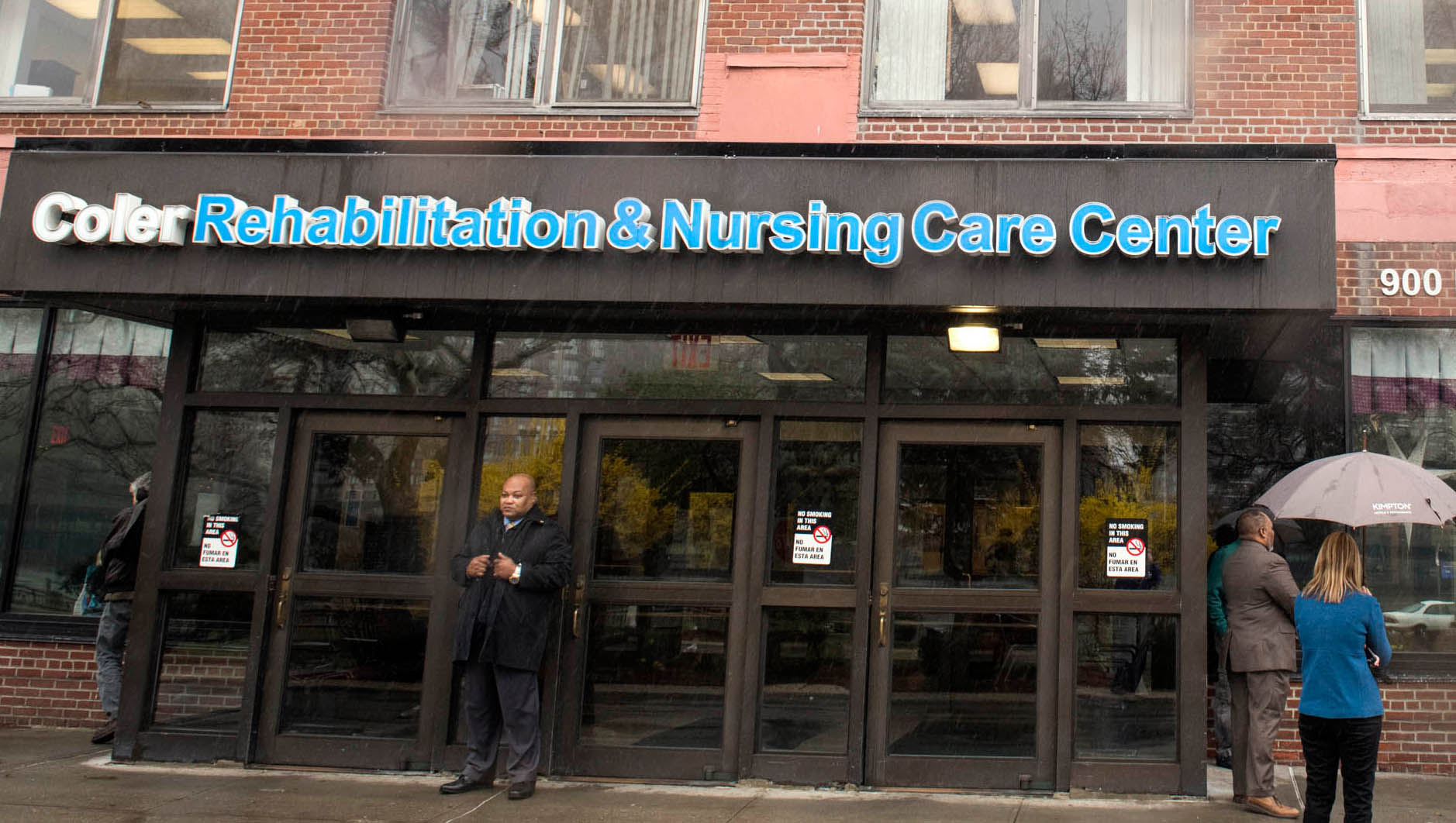
The coronavirus crisis put a spotlight on nursing homes (photo: Ed Reed/mayor's office)
COVID-19 has forced us to face a long-known, but ignored, truth: nursing homes are not desirable places to age. And the racial disparities in quality of health care at these facilities was only exacerbated by the pandemic, as we saw higher COVID-19 death rates in facilities with more people of color.
Just within the past month, 743 people have died in New York State of COVID, and 225 of those people were in nursing homes – a staggering 30% of total deaths. The total doesn’t even count people who were shifted from a nursing home to a hospital then died.
Governor Cuomo recently doubled down on his position that being at a nursing home was safer than having a personal aide caring for you at home. But senior and disabled residents who rely on consumer directed personal assistance (CDPA), a program that lets them hire their own caregivers so they can continue to live independently, would disagree.
A survey of consumers using CDPA, conducted by Consumer Directed Personal Assistance Association of New York State (CDPAANYS) during the COVID-19 pandemic, showed that chief among the concerns expressed by consumers statewide was a fear of being institutionalized.
Without CDPA contributing to shrinking nursing home populations, the tragedy that has played out over the last several months and continues today would have been even worse. Despite this, over $200 million in state budget cuts to CDPA over two years, including a $45 million cut at the height of the outbreak in April to the wages of these personal assistants providing at-home care, have threatened the ability of the program to be effective at a time when it’s needed most.
This $45 million represents a 25% cut to wages and benefits for frontline workers, decided on by the governor’s Medicaid Redesign Team earlier this year, despite a study showing low wages were one of the chief obstacles to both recruitment and retention of homecare workers.
As our population has aged, CDPA has played an increased role in the long-term care system for a host of reasons. Nursing homes have never been desirable, and the Americans with Disabilities Act (ADA) has forced states to utilize more community-based options. Accessibility to CDPA has been a key factor in individuals who need home care being able to remain independent and stay within their communities and homes, and during the COVID crisis it may very well have saved some of their lives.
CDPA has grown rapidly as a more popular alternative to traditional forms of home care in which an agency sends workers to your home based on availability. CDPA is more flexible, letting people set their own care schedules, and because the program allows people to recruit and hire their own workers, it’s also proven exceptional at narrowing the language and cultural gaps that plague our health-care system.
Because those caregivers hired can also be friends or family, it has created options for those who do not have the luxury of being an “informal,” or unpaid, support for their family due to their economic reality. In the communities hit hardest by COVID-19 and broader health disparities, informal care often means sacrificing a paycheck.
Over the past five years the number of people using CDPA has more than doubled to about 80,000. Over the same five-year period, New York closed over 1,800 nursing home beds.
Additionally, as the epicenter of the national shortage in home care workers, New York does not have enough home care workers to handle the increased demands of our rapidly aging population, increasingly composed of immigrants and people of color living in poverty.
Regardless, Governor Cuomo and the Legislature cut funding for CDPA by that $200-plus million in just the past two years alone.
With so many nursing home deaths within our state, New Yorkers will be further spurred to look for alternatives to care for their senior family members who need it. Unfortunately, our state's response, the past few years, has been to cut long-term care services for those most in need. This position was wrong before the crisis and is still wrong for our seniors and disabled populations who wish to stay in their communities. We should instead be investing more into effective, community-based health services like CDPA to address health disparities and improve outcomes.
Our leaders must resist harmful cuts and instead enact popular proposals like raising taxes on the wealthy to bring in revenue that can be used for essential services.
CDPA’s growth has allowed the state to reduce the already devastating impact that health disparities and confinement to nursing homes are producing. That growth, while it may not have been planned, is not unreasonable given the relative increase of the aging population, the closure of almost 2,000 nursing home beds, and the shortages of traditional home care staff. For all its horrors, COVID-19 presents us an opportunity to right historical wrongs. Shame on us if we choose not to take it.
***
Bryan O’Malley is Executive Director of the Consumer Directed Personal Assistance Association of New York State.
***
Have an op-ed idea or submission for Gotham Gazette? Email This email address is being protected from spambots. You need JavaScript enabled to view it.
How New York Must Respond to New Covid-Related Challenges as Communities of Color Face Deadly Summer Heat
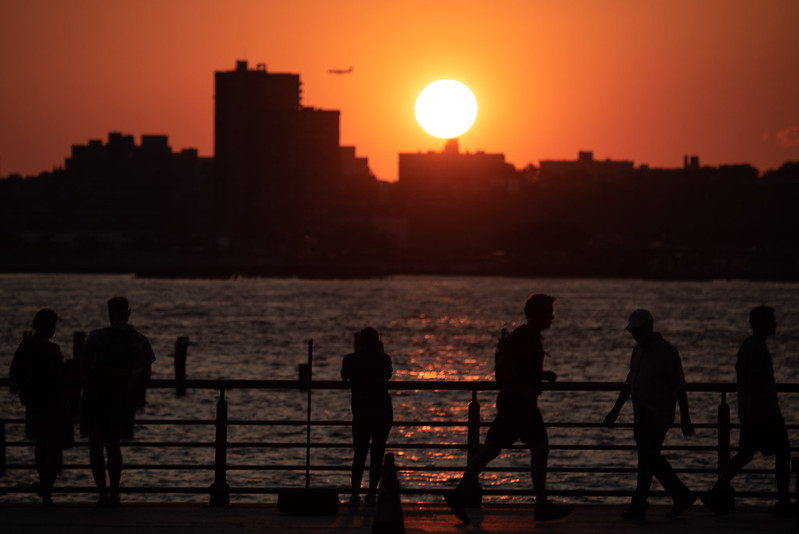
A heat wave is here (photo: Michael Appleton/Mayor's Office)
Heat kills. It is the deadliest form of weather. And it kills Black and brown people at a higher rate than whites.
This should no longer be news. The COVID-19 pandemic has dramatically exposed the many brutal inequities in our society, which have been overlooked and outright ignored by decision-makers for far too long. In the United States, generations of Black and brown people have had to endure systematic and institutional racism that has resulted in disproportionately high incidences of COVID-19 cases and mortality rates.
And with the intense summer heat having arrived, we are even more concerned because the hardships that increase COVID-19 susceptibility are the same hardships that increase heat-illness susceptibility — and in the same communities. More people are staying home, have compromised immune systems, and need safe spaces to get cool.
Annually, there are around 100 heat-related deaths, and over 400 hospitalizations and emergency room visits from extreme heat exposure in New York City. This rate will increase as summers become hotter due to the climate crisis. And, the impact is not equal. The New York City Department of Health found that neighborhoods such as East and Central Harlem, which are predominantly Black and Latino, have higher vulnerability to heat-related illness or death.
The disproportionate impacts of extreme heat are not new, nor are the solutions – such as decreasing fossil fuel emissions, designing our cities to adapt to extreme heat, and providing people with adequate cooling. However, due to the pandemic, the health threats of extreme heat are raising additional challenges that must be addressed to avoid an even deadlier summer.
Action must be taken immediately.
First, we must consider the increased importance of having adequate cooling in our homes. This summer, more people will be spending more time at home. Low-income families and families of color are more likely to be unable to access and/or afford adequate cooling in their homes, and are more likely to experience health impacts such as heat stroke, heat exhaustion, and exacerbated existing chronic conditions.
Over 85 percent of heat-stroke deaths occurred in homes without a working air conditioner, or with an air conditioner that was not used. Considering that New Yorkers typically pay 20 to 30 percent more for utilities during the summer, and within that black renters typically pay more for energy than white renters, it is especially important that low-income households have access to free air conditioners and receive significant utility bill subsidies. Mayor de Blasio’s new and ongoing program to install thousands of free air conditioners in the homes of low-income seniors is welcome, and should be quickly expanded to other households.
Second, New York City and New York State policymakers and public health workers must consider how health-care utilization will be impacted due to heat. People that may normally seek care for heat exposure may avoid health-care spaces this year for fear of contracting COVID-19. Clear, multilingual health communications in the most at-risk neighborhoods is vital for ensuring people access emergency care for heat illnesses.
Third, New York City and New York State must consider the sociocultural and psychological impacts of extreme heat in a COVID-19 summer. Culturally, many communities of color rely on one another for support. On a hot day if you don’t have air conditioning in your home, you may go to your aunt’s or your brother’s house to find a cool room. This summer, households that would have relied on one another are left with either risking their health to find social, emotional, and material support, or not have that support at all.
It isn’t enough to offer spaces to cool down that happen to be in hardest hit neighborhoods, we must partner with communities to find safe and healthy spaces for gathering that are culturally significant and will therefore be more utilized.
Finally, decision-makers must consider how anti-Blackness and white supremacy compounds extreme heat issues. As the city began to re-open, there were reports of increased policing in Black communities, disguised as COVID-19 safety measures. For example, the disproportionate levels of policing at green spaces in Black and brown communities has left many of these community members fearful of visiting parks, or simply going outside while wearing masks. Utilizing outdoor space is a key piece of keeping safe from extreme heat. If their home lacks adequate cooling, and going outdoors is unsafe, where do our community members go for respite from the heat? When needing to increase COVID-19 safety enforcement, it is important to keep the NYPD far from the job and instead increase the number of Social Distancing Ambassadors trained by the city, who can feel more like peers than violent enforcers.
We have had some wins to protect people this summer, but much more needs to be done. Due to advocacy work, the New York State Public Service Commission voted this month to approve electricity bill rebates for low-income households. And the New York City Mayor’s Office implemented the aforementioned GetCool NYC, with free air conditioners to thousands of qualified vulnerable seniors across the city (though not all who need them are getting them in time for this summer’s heat). We have worked tirelessly for this progress, but there is much more to be done to protect overburdened communities now and in the long-term.
The solution to extreme heat impacts lies in a comprehensive response informed by the communities most impacted by COVID-19 and historical racism. Extreme heat must be treated as a public health problem, not just a climate change problem.
As a precursor to what we are calling the “Heat, Health, and Equity Initiative” to be launched in 2021, WE ACT for Environmental Justice has put forth a set of tangible policy solutions on the state and city levels that will address some of the issues that have contributed to the disparate impact of extreme heat exposure and heat illness on communities of color.
Expanding LIHEAP, the Low Income Home Energy Assistance Program, to fund retrofitting buildings, supporting bills to ensure data collection and publication related to heat is timely, setting minimum temperature for office buildings, installing shade covering on pedestrian streets, upgrading cooling center HVAC systems, and expanding community solar are among some of the many policy recommendations WE ACT has set forth to achieve both short- and long-term solutions for extreme heat.
As we take the time to safely reopen our city, this is an opportunity to find solutions that will not only protect our most impacted communities now, but that can also address environmental racism and help us prepare for future pandemics and disasters.
***
Sonal Jessel, MPH, is a Policy and Advocacy Coordinator at WE ACT for Environmental Justice, where she specializes in addressing the health impacts of extreme heat in low-income communities and communities of color. On Twitter @weact4ej.
***
Have an op-ed idea or submission for Gotham Gazette? Email This email address is being protected from spambots. You need JavaScript enabled to view it.
An Inclusive Recovery Starts With An Inclusive Process
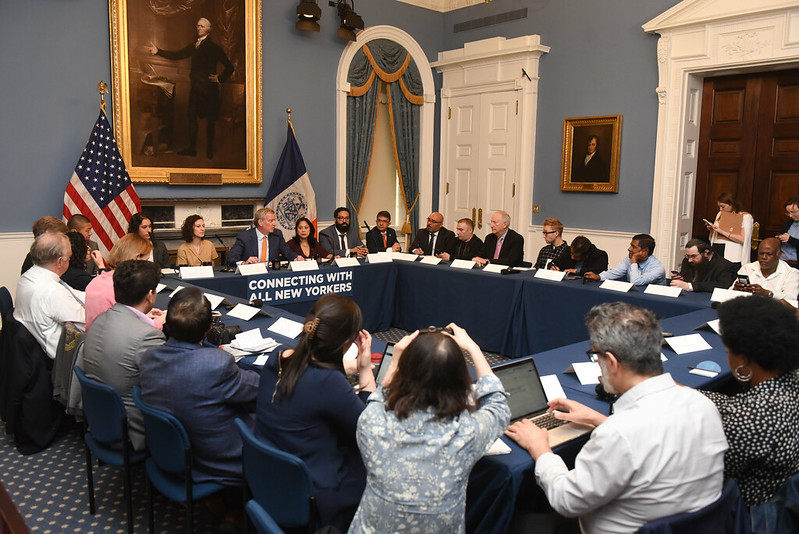
Gather stakeholders around the table (photo: Michael Appleton/Mayor's Office)
Major financial decisions in New York, such as city and state budgets and economic development deals, are typically made behind closed doors in processes that are opaque to the public and rushed through our legislatures. The recent budget deal between Mayor Bill de Blasio and the New York City Council was no different — addressing a $9 billion shortfall with contingencies and fuzzy math. It included an insufficient plan to restart our economy and will ultimately prove to be shortsighted, as we approach a fiscal crisis that will affect us for years.
We cannot meet this generational economic challenge by using the same old standard operating procedures and backroom deals. In order to create an inclusive recovery that works for all New Yorkers, we must include input from all New Yorkers.
New York was able to recover from the 1975 fiscal crisis in part because of the empowerment of a commission that led to the creation of the New York State Emergency Financial Control Board and other safeguards that were subsequently implemented.
While both the Governor and Mayor are correctly advocating for significant help in the form of financial aid from Washington, an inclusive commission of experts should be in place to implement a strategy for using that aid and back-up plans if it doesn't arrive.
The commission should include labor leaders of both public and private sector unions, whose organizations represent approximately 22% of New York City’s total workforce and provide a foundation for a prosperous middle class. Our small business community should be represented, in particular the hospitality industry that was hit so hard by the COVID-19 crisis. Voices that are too often left out of the process, such as leaders from immigrant and Black communities, tenant leaders, and others must play a central role in identifying areas of need, and the most direct means to assist New York families in crisis.
As the former Finance Chair of the New York City Council, I know that there is no substitute for expertise. Elected officials and government experts on budget and finance, including our current and former city Comptrollers, should also be important and necessary parts of this commission.
An inclusive recovery must include new sources of revenue so that we don’t have to balance our budget on cuts alone. I strongly support the full legalization of marijuana, with the revenue generated from new taxes split between New York State and the local municipalities where the sales originate. I also believe it is time to legalize the multibillion-dollar industry of sports wagering in New York in a manner that is competitive with our neighboring states. These simple policy changes will create important sustainable jobs for the 21st century.
An inclusive commission would be instrumental in ensuring that these are union jobs wherever possible, and that jobs and new tax revenue directly benefit individuals from our most vulnerable communities.
While the specific structure and role of a commission could be up for debate, there is no denying that our city will come back stronger if we include more voices in an open, honest decision-making process.
***
David Weprin is a member of the New York State Assembly and candidate for New York City Comptroller. On Twitter @DavidWeprin.
***
Have an op-ed idea or submission for Gotham Gazette? Email This email address is being protected from spambots. You need JavaScript enabled to view it.
We Should Never Have to Choose Between Life and Democracy
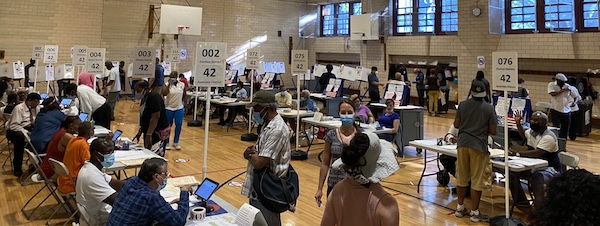
In-person voting during a pandemic (photo: Gotham Gazette)
We should never have to decide between public health and democracy. We must have both.
We hoped that voter suppression was a thing of the past, and yet it is still present not just in the South but in the South Bronx and across the country.
We are witnessing a public health and democratic crisis that must be addressed immediately—otherwise, lives will be taken as electoral gains are also stolen.
In short, the coronavirus crisis has cast a light on the deteriorating health of American democracy, and it’s time we act urgently.
In the midst of a global pandemic, state and local governments have had to adjust the way voters participate in elections to minimize transmission of COVID-19 and keep people safe, including using early voting and mail-in ballots so that people have options to cast their vote.
However, the past few months have shown that our electoral system is still in dire need of repair. The fact that it is taking weeks to count ballots in the South Bronx, for example, does not bode well for upcoming elections—the most important of which is defeating Donald Trump in November.
In Pennsylvania, tens of thousands of voters received their ballots in the mail after the election had passed. Baltimore residents had to wait more than a week longer to receive their ballots than residents of the other parts of Maryland. More than 1,000 voters in New Mexico were disenfranchised because their mail-in ballots arrived too late to be counted on Election Day.
In Georgia, tens of thousands of voters had yet to receive their ballots by mail on the day before the primary election, and more than 10% of in-person polling places in the state had been closed, forcing many voters to wait for hours in line at those sites that remained open.
Unfortunately, in New York’s June primary elections, we saw more of the same—delayed or missing ballots causing the disenfranchisement of people unable to leave their homes due to health concerns; polling places closed or moved without explanation; lifelong Democrats told to submit an affidavit ballot because their party status was somehow in question; voters forced to wait hours in line in the midst of a pandemic.
There were just under 800,000 absentee ballots sent out by the New York City Board of Elections and more than 400,000 absentee ballots returned by voters. However, we still have no clarity on the actual number of people who never received their ballots or received them late, nor the actual timetable of when the ballots were mailed out in the first place.
We also still don't know why the top voting Black polling place in my Assembly District (the 79th) was moved nor why several of our polling places were opened late nor why so many persons were only given presidential primary ballots nor why so many largely Black polling places have two-hour-plus lines due to insufficient equipment and scanners going down. Some may call these all innocent errors, but there's simply too much consistency to ignore, too much likely intentionality to overlook.
When the government needs to contact us to collect money, the mail system works seamlessly. However, from delayed stimulus checks earlier this year to now delayed ballots, we are not helping our fellow Americans to recover and exercise their right to participate in our democracy.
Simply put, it is unacceptable that untold numbers of Americans are being asked to literally risk their lives to participate in the electoral process because of the inadequacies of the vote-by-mail system and boards of elections.
I am proposing the following set of remedies.
First, all poll workers must receive non-partisan training, be treated as skilled employees with approved certification, and have no connection to any candidate or campaign. Moreover, the leadership and staff at boards of elections should always be independently appointed.
Second, there must be a public schedule that explicitly sets forth when ballots should be received by voters in the mail, ensuring some degree of government accountability. In addition, there must be a tracking system to notify voters of ballot distribution and arrival, just as there would be for any package purchased online.
Third, if someone is found to have participated in voter suppression, he or she must be immediately referred to the New York State Attorney General for investigation.
Fourth, we must ensure that devices at polling places are able to identify a voter who lives within that site's jurisdiction so that people are not unjustly turned away from their polling site or forced to submit an affidavit ballot.
Fifth, the public must be given transparency as to why a person is asked to vote by affidavit ballot or has had their ballot invalidated. My team has identified several hundred affidavit ballots that were initially deemed invalid, many for simply undemocratic reasons such as a person who is confirmed by the Board of Elections to be a Democrat had their ballot invalidated because they didn’t check a box for why they were voting by affidavit. What if the person didn’t know why they were being forced to vote affidavit or the poll worker didn’t actually have a reason?
Sixth, there must be emergency allocations for local boards of elections and postal services to have sufficient capacity prior to the election. In the event that legal action is required in the 15th Congressional District -- or elsewhere -- to review the election results, that election should not be certified until the legal action is resolved. This should be the standard across the board.
Seventh, wherever possible, a public hearing and approval process must be established prior to moving a polling site.
It pains me to think that this undemocratic process has occurred over the course of many decades. Anyone who has contributed to the intentional disenfranchisement and suppression of voters should be ashamed, as your silence has led to the voices of New Yorkers not being heard.
If you voted by affidavit or absentee ballot, you should demand an immediate answer as to whether your ballot has been deemed valid and counted in this electoral contest. Tens of thousands of New Yorkers are thinking right now that their vote was counted, but unbeknownst to them, and for some undisclosed reason, their ballot was in fact voided. We should not have to sift through countless reams of paper to discover that New Yorkers—especially those in low-income, Black and brown neighborhoods—are being unfairly disenfranchised and suppressed.
The reforms outlined above are necessary because these issues are not theoretical. A recent study found that Wisconsin’s decision to hold an in-person election in April led to a substantial spike in coronavirus infections. In other words, these election-related issues are a matter of life and death. If we’re going to offer the early and mail-in voting that we should, it must work, and work well, to ensure that New Yorkers and all American voters have their right to vote protected and ensured.
As I continue to cry and mourn the loss of Civil Rights icon Rep. John Lewis, whom I had the honor to meet several times and bestowed upon me one of his final endorsements, my spirit reflects heavily on one of his many profound sayings: "If you see something that is not right, not fair, not just, you have a moral obligation to do something about it." As we enter the fourth week after our election with so many unresolved problems, I'm writing this because we have a moral obligation to end the voter disenfranchisement and suppression that occurs across New York State and this country.
Countless numbers of our ancestors marched, bled, and died for the inalienable right to vote. We shouldn’t have to risk death to vote again.
***
Michael Blake is a member of the state Assembly and candidate for Congress in the Bronx. On Twitter @MrMikeBlake.
***
Have an op-ed idea or submission for Gotham Gazette? Email This email address is being protected from spambots. You need JavaScript enabled to view it.
Federal Funding Up for NYPD, Down for Human Services
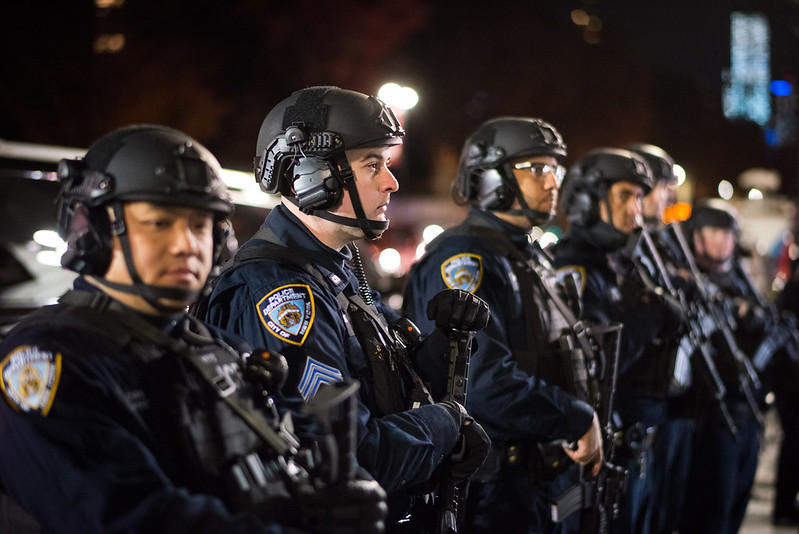
NYPD officers (photo: Edwin J. Torres/Mayor's Office)
Budgets, as the saying goes, reflect our values. Take a closer look at where the money goes – or doesn’t – and you can readily see our nation’s priorities.
This is perhaps never truer than during an economic downturn. At FPWA, we’ve examined the trends in federal spending for human services using our online Federal Funds Tracker. We know that since the Great Recession ten years ago, the federal government’s austere budgets have left human service programs in New York City deeply underfunded. Such policy choices have disproportionately harmed Black New Yorkers and other communities of color. Now, a decade later, the coronavirus pandemic is dealing another uneven blow to the same communities.
Our Tracker tells us where the federal money didn’t go. But what do we learn when we look at where it did go? What does the data reveal about our priorities and something more – our systemic biases?
As recent anti-police brutality protests offered hope of “arousing the nation’s consciousness” about systemic racism, police reform, and social injustices, we used the Tracker’s open data infrastructure to explore trends in federal funding for policing compared to human services.
We found that between fiscal years (FY) 2010 and 2019, federal funding for New York City’s human services fell by $344 million (8 percent) while funding for the New York City Police Department (NYPD) increased by $144 million (129 percent).
Driving this growth in federal funding for the NYPD is the ‘Urban Area Security Initiatives’ (UASI) – a formula grant that is intended to “protect against terrorism in high-threat, high-density urban areas,” but that some civil liberty, humanitarian, and religious organizations have identified as being central to the “acceleration of police militarization and lack of accountability.”
Nationally, $605 million was appropriated for UASI in federal fiscal year (FFY) 2020 – an increase of $25 million since FFY 2019, and $9.4 billion since the program was signed into law in the 2003 Omnibus Appropriations Act.
New York City has received a quarter ($2.3 billion) of all UASI funding. In FY 2019, the NYPD received more than $117 million for UASI, representing approximately half of the department’s federal funding. The vast majority of this funding supports NYPD’s ‘security/counter-terrorism’ program, while Housing and Preservation Development (HPD) and Department of Health and Mental Hygiene (DOHMH) receive a small slice each.
Subject matter experts in policing and counterterrorism and those with a better grasp of NYPD’s opaque budget will better understand how NYPD’s UASI funding is spent, the efficacy of the nearly two-decade-old program, and the extent to which other programs such as the Department of Defense’s 1033 program have militarized the NYPD. We do know, however, that the “nexus to terrorism” funding requirement in the UASI program has enabled police departments across the nation to acquire highly militarized weapons such as body armor, bayonets, automatic rifles, grenade launchers, armored vehicles, and surveillance drones.
These cast-off weapons from the Pentagon are intended to support counterterrorism efforts, but the resulting militarization of police forces is also used in the everyday policing of Black, Latino, and poor communities, the illegal surveillance of Muslim communities, and the escalation of police violence against protestors. In fact, the UASI program came under scrutiny following the weeks-long standoff between anti-police brutality protestors and heavily armed police forces in Ferguson, MO.
FPWA’s online Federal Funds Tracker tool visualizes trends in federal dollars for human services in New York City, but it also allows users to download trend data on federal grants that support all categories of spending. As policing in America is more closely examined, especially as experienced by Black Americans, these findings gives credence to concerns expressed by protesters, advocates, and policymakers who wish to see the budgets of police departments more closely scrutinized, and more dollars reallocated towards human services such as education, housing, mental health, and other social services.
Black Americans have been disproportionately harmed by each of the last decade’s crises and disinvestments from programs that improve people’s lives, while simultaneously confronting systemic racism that is present – and well-funded – today, such as militarized and discriminatory policing. As Congress begins preparing next fiscal year’s budget, it is encouraging to see bipartisan legislation that acknowledges the federal government’s role in the militarization of local police departments, but closer scrutiny will be required to truly address the full scope of budget tradeoffs that exacerbate racial injustices.
***
Derek Thomas is Senior Fiscal Policy Analyst; Matan Diner Fiscal Policy Fellow; and Gaurav Gupta-Casale is Fiscal Policy Analyst at FPWA. On Twitter @FPWA.
***
Have an op-ed idea or submission for Gotham Gazette? Email This email address is being protected from spambots. You need JavaScript enabled to view it.

